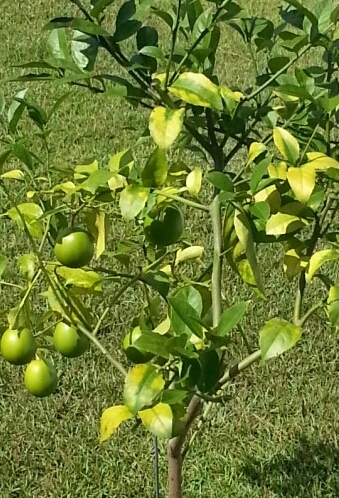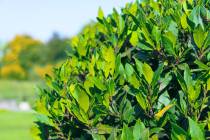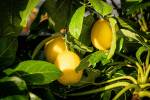Wait until February to prune citrus
Q: Should I be pruning my lemon and grapefruit bushes now?
A: Of course, the most important thing right now is protection from low temperatures, which I have talked about repeatedly. As I have said before, this is not citrus country. Not because it’s too hot, but because it gets too cold in the winter. Low winter temperatures can cause a lot of different problems for citrus in our climate.
Delay pruning citrus until late February. If there are to be very low temperatures, they’re more likely to occur through mid-February. If you delay pruning until the end of February, you will not have to prune twice. If you prune correctly, you shouldn’t remove any new fruit that might be developing.
Citrus are not pruned as much as many other fruit trees. First, they should not be a shrub. Prune them to a tree form with a single trunk. When pruning, start at the bottom of the tree. Remove all suckers coming from the base or from the graft union (rootstock) and below.
Lowest limbs on the tree should come from the trunk at about knee height. Remove any strong suckers growing from limbs that are strongly upright or vertical. Remove crossed branches, broken branches or diseased branches.
Nearly all pruning cuts should remove entire branches from a place where they join another branch or the trunk. Citrus benefits from allowing some sunlight to reach the interior of the tree canopy.
If a limb is growing a few inches above another limb, consider removing one of the limbs entirely to allow more light into the interior. Do not remove too many limbs or fruit can get sunburned.
Q: How do you get rid of horsenettle and how did I get it in my yard? Are the yellow berries poisonous?
A: When talking about weeds, confusion happens when using common names. Plants can have several different common names.
I think the plant you are calling horsenettle is what I would call silverleaf nightshade. This weed is frequently found in older pastures and horse property. Horses don’t like it because it has spines on stems and leaves that make it difficult for animals to eat.
Even if they could eat it, they wouldn’t like the taste. This plant is somewhat poisonous. Animals may graze other plants, but they leave this plant alone so it flourishes once it gets started.
It is difficult to control because it spreads to new locations via underground stems called rhizomes. New plants pop up from the mother plant 5 to 10 feet away, particularly after a heavy rain. Weed killers or herbicides may kill plants with aboveground leaves, but new plants pop up from the underground stems in new locations in a matter of days.
The plant grows to about 6 to 8 inches tall and begins flowering. The flowers are white to purplish and resemble flowers of potatoes and nightshade, both in the tomato family of plants. Small, round fruits are produced from the flowers, marble size, that resemble other nightshades and tomatillo. All the plant is poisonous, particularly the fruit when it is green. The fruit turns yellow when it is mature.
The natural or organic way to control this plant is removal of the new leaves and shoots as soon as they are seen. This can be done with a hoe in the landscape or garden or dandelion weeder if it’s in a lawn. If the tops are removed as soon as they are seen, there will be a flourish of new growth popping from the ground from the rhizomes.
This resilience will last a month or two and then growth will decline if you stay on top of it. If you remain diligent for one growing season, you will see a definite decline in new growth popping from the ground.
This weed is easier to control the second growing season. By the third growing season, it occasionally pops up but is much more manageable.
The other method of control involves chemicals. The most effective chemicals are those that also control woody plants. These are usually safe to use in and around lawns but can be a problem when sprayed near woody landscape plants. Look for chemicals that control oxalis or wood sorrel and unwanted woody plants as stated on their label.
Direct the spray to the leaves of this weed and not to the soil. The spray should wet the leaves thoroughly until they begin dripping. Add a wetting agent to the spray solution. This helps this chemical enter the plant and not run off the leaves to the ground.
Q: We planted a Mexican saguaro 13 years ago when it was about 3 feet tall. It has since grown to 12 to 15 feet and has grown arms. Every year we cover it with burlap to help prevent freezing. We can never get a direct answer if we need to continue covering it with burlap or not.
A: I have never understood the purpose of wrapping burlap around a plant such as saguaro all winter long. Personally, I think this could create quite a bit of damage to the plant, particularly during wet winters.
I saw damage to saguaros wrapped in burlap a few years back. These plants were wrapped in late November or December and unwrapped in late February or early March. A couple of winters were wet ones with rain on a few occasions.
After unwrapping them, the surface of the saguaros was damaged: large brown patches in several places on the plant’s surface. I notice now the saguaros are no longer wrapped in burlap but left exposed to the elements.
When wrapping a plant, it is better to use a frost blanket rather than burlap. Frost blankets provide about 5 to 6 degrees F protection and allow a fair amount of light, air and moisture to pass through them. Frost blankets can be left covering plants for extended periods.
Don’t fertilize winter-tender plants such as saguaro after Aug. 1. By October, withhold water so the moist inside of the plant becomes more concentrated with nutrients. This concentration of nutrients acts like a natural antifreeze.
Q: For the past couple of years, scattered branches on my Chinese pistache have been turning brown on the east side of the tree. All leaves are green and healthy until about June when it gets hot. I checked branches for verticillium wilt disease, and there is no discoloration or brown streaks inside the branch.
A: As you have already figured out, the browning of leaves or leaf scorch is due to a lack of water to those leaves. The next question becomes, “Why is water not getting to the leaves?”
The east side of the tree is typically a cooler side of the tree unless there is reflected light or heat from windows or bright colored walls. You said “scattered branches,” which means leaf scorch is not over the entire tree but on individual branches on one side.
If there is not enough applied water for the tree, the hot sides of the tree are affected more than cooler sides of the tree. If leaves are scorching on individual branches, then something is blocking and preventing water from reaching the leaves inside those branches.
Verticillium wilt is a disease that plugs the vascular tissue. Vascular tissue conducts water to the leaves. Verticillium wilt disease is a good candidate for causing this problem.
Verticillium wilt disease can be difficult to identify. In some cases, it is virtually impossible to confirm without a pathologist. Assume it is and remove these branches. Sanitize your equipment before pruning and between each new cut.
Bob Morris is a horticulture expert living in Las Vegas and professor emeritus for the University of Nevada. Visit his blog at xtremehorticulture.blogspot.com. Send questions to Extremehort@aol.com.




























